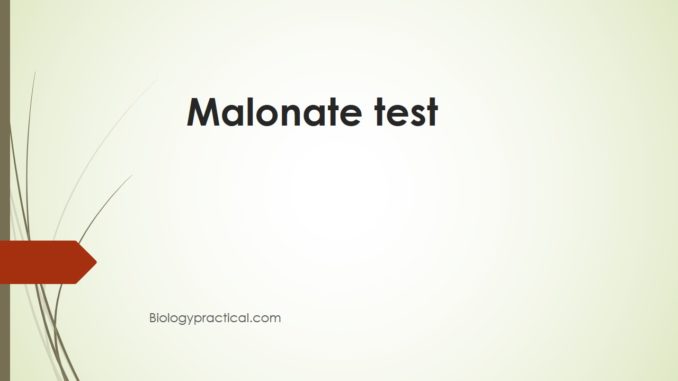
Objective:
- To check whether the organism is capable of utilizing malonate as sole source of carbon and energy for its growth.
- To categorize organisms on the basis of malonate utilization especially among the Enterobacteriaceae, mainly species of Klebsiella and Salmonella.
Principle:
- The medium employed for the malonate test is malonate broth that contains mineral salts, sodium malonate as the only source of carbon and ammonium sulfate as the only source of nitrogen.
- An organism that is capable of simultaneously utilizing sodium malonate as it’s carbon source and ammonium sulfate as it’s nitrogen source, then it will increase alkalinity of the medium due to the formation of sodium hydroxide and sodium bicarbonate as a result of fermentation of sodium malonate. To indicate this shift of pH towards alkalinity, bromothymol blue is used as an indicator. It changes its native green color to light blue or Prussian blue in alkaline medium.
- If no such organism is present i.e. if malonate negative organisms are present then the bromothymol blue turns yellow indicating acidity.
Requirements:
- Media: composition
Ingredients per litre of deionized water
– yeast extract —————————– 1.0 g
– ammonium sulphate ——————– 2.0 g
– dipotassium phosphate ———— 0.6 g
– monopotassium phosphate ——– 0.4 g
– sodium chloride ——————— 2.0 g
– sodium malonate ————————– 3.0 g
– glucose —————————————– 0.25 g
– bromothymol blue ———————— 0.025 g- Final pH-6.7
- Store at 2 to 8°C
- Equipments:
- Sterile inoculating loops or sticks
- Incubator at 35 to 37°C
Procedure:
- Using a loop or stick, inoculate tube with a light inoculum picked from the centre of a well-isolated colony (no visible turbidity)
- Incubate aerobically at 35 to 37°C for up to 48 hr.
- Observe a colour change from green to blue along the slant at 24 and 48 hrs.
Observations and Results Interpretation:
- The colour change of bromothymol blue from green to blue is suggestive of growth of organism and positive malonate test.
- The negative malonate test is indicated by no colour change or change of colour from green to yellow due to fermentation of glucose.

Limitations:
- Some reactions are slight in nature compared to the uninoculated tube when reading which creates difficulty in interpretation.
- Reactions should not be read before 48 hrs.
- Some other additional media such as yeast extract and glucose are required for growth of species as Salmonella but are generally not required for other species.
